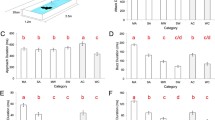Abstract.
When searching for insects along edges, Barbastella barbastellus alternated between two signal types. Type-2 signals had durations around 6 ms and were composed of an initial shallowly downward frequency modulated component, starting at about 45 kHz and followed by a shorter more steeply modulated component that ended at about 32 kHz. Type-1 signals were rather stereotyped with durations around 2.5 ms and a very short rise time. They covered an approximately 8 kHz-wide frequency band positioned just below the 12–15 kHz-wide frequency band of type-2 signals, with no or small frequency overlap. In the recordings, type-1 signals almost had always a higher amplitude than type-2 signals, at least partly caused by head movements. Assuming that signal structure reflects function, we hypothesize that type-2 signals have the same adaptive value as the signals with a broadband and narrowband component of other vespertilionids, but with a reverse arrangement of the signal elements. Like the broadband component of the type-2 signals, type-1 signals are well suited to localize background targets. Thus, the localization component may be distributed among two signals separated in time, which has the advantage that both signals can be varied independently in the direction of emission and in amplitude.
Similar content being viewed by others
Author information
Authors and Affiliations
Additional information
Electronic Publication
Rights and permissions
About this article
Cite this article
Denzinger, A., Siemers, B.M., Schaub, A. et al. Echolocation by the barbastelle bat, Barbastella barbastellus. J Comp Physiol A 187, 521–528 (2001). https://doi.org/10.1007/s003590100223
Accepted:
Issue Date:
DOI: https://doi.org/10.1007/s003590100223




